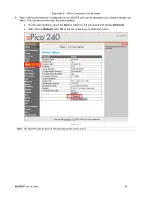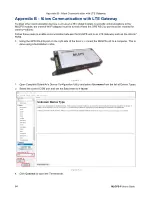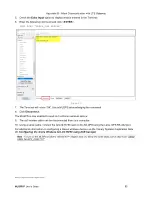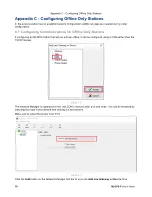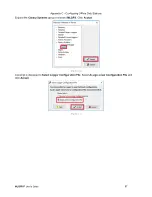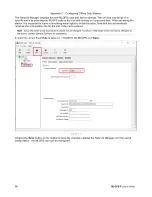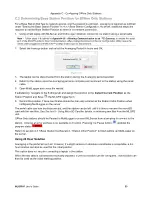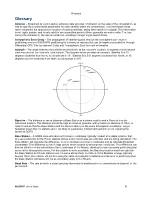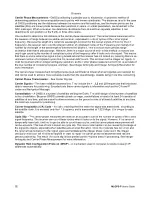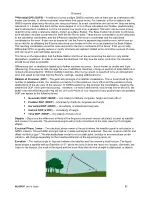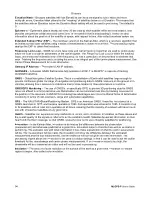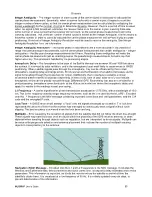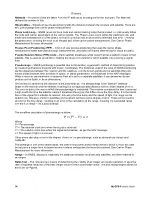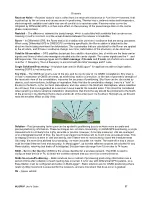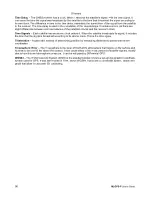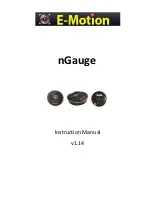
Glossary
MLGPS-P
User's Guide
97
Receiver Noise
‒ Receiver noise is noise, either from the receiver's electronics or from the environment, that
is picked up by the antenna and causes errors in positioning. Thermal noise, antenna noise and temperature,
electromagnetic radiation and cable loss can all contribute to receiver noise. Receiver noise cannot be
mitigated by Differential GPS, and has more effect on the accuracy of the pseudorange than on the carrier
phase measurement.
Residual
‒ The difference between the pseudorange, which is calculated with variables that contain errors,
meaning it itself is incorrect, and the actual distance between the receiver and satellite.
Rover
‒ In Differential GPS, the Rover station is a station with unknown coordinates that are being calculated.
When using Differential GPS in GNSS/GPS monitoring specifically, the Rover station is attached to the
structure that is being monitored for deformation. The coordinates that are calculated for the Rover are applied
to the structure, and if those coordinates change over time, deformation of the structure can be observed.
Satellite Observables
‒ GPS satellites broadcast five
satellite observables
, two of which are the base carrier
signals and three of which are messages encoded onto the carrier signals. The carrier signals are the
L1
and
L2
frequencies. The message types are the
NAV message
,
C/A code
and
P code
, all of which are encoded
onto the L1 frequency. The L2 frequency is encoded with the NAV message and P code.
Single Solutions/Processing
‒ A solution type used in MultiLogger
for applications with a single station,
meaning DGPS is not being used.
Sky View
‒ The GNSS receiver's view of the sky, and hence its view of the GNSS constellation. Sky View is
critical in installation of GNSS antennas, as minimizing
dilution of precision
, or the lack of geometric strength of
the receiver's view of the constellation, improves the accuracy of positioning. Sky View can be obstructed by
objects, such as mountains, buildings or vegetation. Note that due to constellation design, there is a "hole" in
the sky to the North, in the Northern Hemisphere, and vice versa in the Southern Hemisphere, where satellites
do not travel, that is exaggerated as a receiver moves towards the celestial poles. This should be considered
when selecting a site for antenna installation: obstructions that block the sky should be positioned to the North
of the antenna in the Northern Hemisphere and South of the antenna in the Southern Hemisphere, as this will
have the smallest effect on Sky View.
Solution
‒ Post processing techniques can be applied to positioning data to achieve more accurate and
precise positioning information. These techniques are
solutions
. Essentially, in GNSS/GPS positioning, a single
measurement is not likely to be highly accurate or precise. However, if multiple measurements are averaged
over a designated period of time, the resulting averaged coordinates will be much more accurate/precise. This
averaging of results is done in post processing, and it takes time to receive and process the measurements.
Generally, the more time allowed for processing, the more accurate the results. The trade-off is that a choice
must be made between time and accuracy. In MultiLogger
, up to three different solutions are allowed for any
Rover station, meaning that trade-off is mitigated. Solution intervals range from 15 minutes to 24 hours.
SSID
‒
S
ervice
S
et
Id
entifier (SSID) is the unique identifier for a wireless network. The SSID is used to
configure each device or PC to select the wireless network that you want it to communicate on.
Static Solutions/Positioning
‒ Static solutions are a method of processing positioning information over a
period of time after collection of each reading has occurred. It is for use with Differential GPS systems, so a
Base Station must be configured and active in MultiLogger
. Static solutions are for GNSS positioning where
relatively little movement is expected for the receivers, and any movement that does occur is gradual.
SV
‒
Space vehicle

